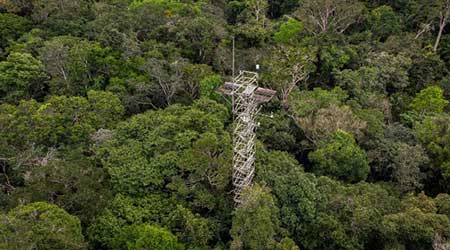Date : 27/05/2023
Relevance : GS-3: Science and Technology- developments and their applications and effects in everyday life: Conservation, environmental pollution and degradation, environmental impact assessment.
Key Phrases: Rings of Carbon Dioxide, Amazon Rainforest, AmazonFACE, Carbon Sequestration, Climate Change, Carbon Emissions, Deforestation, Photosynthesis, Free Air CO2 Enrichment.
Context:
- Brazil is currently constructing a complex of towers in the heart of
the Amazon rainforest.
- This unique structure consists of six rings and is designed to release sprays of carbon dioxide into the surrounding environment.
Introduction:
- In a groundbreaking endeavour, Brazil is constructing a unique
structure deep within the Amazon rainforest.
- Comprising six rings of towers, this ambitious project, named AmazonFACE, aims to simulate the effects of climate change on the world's largest tropical forest.
- By spraying mists of carbon dioxide into the rainforest, scientists hope to gain insight into its carbon sequestration capacity and ascertain if the Amazon has a tipping point that could lead to irreversible damage.
- This article explores the significance of AmazonFACE and its potential implications for understanding climate change in the Amazon.
Understanding the Amazon's Carbon Sequestration
- The Amazon rainforest plays a vital role in mitigating climate change by
absorbing substantial amounts of carbon dioxide from the atmosphere.
- Through the process of photosynthesis, plants convert carbon dioxide, water, and sunlight into sugars, releasing oxygen as a byproduct.
- However, the extent to which increased carbon dioxide concentrations impact the Amazon's carbon sequestration capabilities remains uncertain.
- AmazonFACE, inspired by the Free Air CO2 Enrichment (FACE) technology developed by Brookhaven National Laboratory, seeks to shed light on this crucial aspect of climate change.
The Importance of Studying Carbon Dioxide Effects
- A prominent scientist involved in the AmazonFACE project, highlights
the necessity of studying the impact of heightened carbon dioxide
concentrations on the Amazon rainforest.
- He argues that the tipping point of the Amazon is more closely tied to climate change than the rate of deforestation alone.
- While halting deforestation remains a priority, combating climate change caused by atmospheric factors requires international collaboration.
- His perspective challenges previous research, suggesting that even if deforestation is halted, the forest remains susceptible to the consequences of climate change.
Construction and Operation of AmazonFACE
- The construction of AmazonFACE is currently underway, with the initial two rings expected to be operational by early August.
- Each ring consists of 16 aluminium towers, towering as high as a 12-story building. The carbon dioxide necessary for the experiment will be supplied by three companies to ensure an uninterrupted supply.
- Located approximately 70 km north of Manaus, the project is
spearheaded by the National Institute for Amazon Research and supported
financially by the British government, pledging $9 million.
- It is anticipated to be fully operational by mid-2024.
Potential Replication and Regional Variations
- Atmospheric chemist, while not directly involved with AmazonFACE, lauds the initiative and suggests the replication of the project in the four quadrants of the Amazon.
- The carbon absorption capacity of the rainforest varies significantly across the region, which spans an area twice the size of India.
- His endorsement underscores the importance of gaining a comprehensive understanding of the Amazon's response to climate change, considering its immense ecological significance.
Insights from Recent Research
- A notable study published in the journal Nature, revealed a concerning
development in the eastern Amazon.
- This region, once a significant carbon sink—a natural absorber of carbon dioxide—has transitioned into a carbon source.
- Such findings emphasize the urgency of realising the intricacies of the Amazon's carbon sequestration processes, particularly in the face of escalating climate change.
Conclusion
- The construction of AmazonFACE marks a significant step toward understanding the impact of climate change on the Amazon rainforest.
- By simulating increased carbon dioxide concentrations, scientists aim to unravel the forest's carbon sequestration capacity and determine if it possesses a tipping point that could lead to irreversible damage.
- This ambitious project holds promise in shedding light on the delicate
balance between the Amazon's ability to absorb carbon dioxide and the
pressures imposed by climate change.
- As the global community grapples with the challenges of climate change, initiatives.
Source: The Hindu
Mains Question:
Q. Explain the concept of carbon sequestration and discuss different techniques used to enhance carbon sequestration in the environment. Provide examples to support your answer. (250 words).







